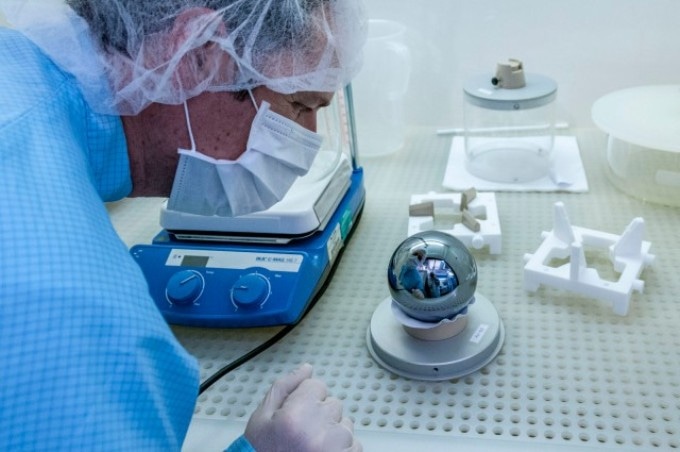Jul 5 2017
The basic unit for measuring mass, namely, prototype kilogram, which is used to calibrate all scales, is becoming outdated. At present, globally, there are ongoing attempts to reformulate the basic unit for measuring mass and consequently to re-evaluate the kilogram with respect to natural constants.
 The silicon sphere to be coated must be handled like a raw egg. On the right in the picture: one of the three-point mounts. CREDIT: Photo Fraunhofer IST.
The silicon sphere to be coated must be handled like a raw egg. On the right in the picture: one of the three-point mounts. CREDIT: Photo Fraunhofer IST.
In order to do this, the Avogadro experiment establishes the number of atoms in nearly precise silicon spheres. Scientists at Fraunhofer have at recent times been successful in homogeneously covering the spherical surfaces with a coating. Consequently, the uncertainty in measurement can be restricted to below 10 mg.
The reason behind the prototype kilogram (i.e. the unit of mass on which the weight of a kilogram is dependent) is becoming lighter by the day is not known to date. At present, Scientists are on the lookout for substitutes for the platinum-iridium alloy artifact kept in a safe in Paris. The fundamental concept is to reformulate the kilogram. Subsequently, the material kilogram will be replaced by a physical constant.
Consequently, a group of Researchers from the Physikalisch-Technische Bundesanstalt (PTB)‒ the national metrology institute of Germany ‒ have been performing experiments on isotope-enriched silicon spheres, which can be used as the new calibration standard. Hence, the Researchers have to ascertain the Avogadro constant, which is equal to the number of atoms in one mole.
We calculate the number of atoms in a sphere and use mathematical methods to obtain the number of atoms per mole. In simple terms, we find out how much a silicon atom weighs and through inverse conclusion can thus determine how many silicon atoms are needed for a kilogram. The mole is the mediator between the atomic mass scale and the kilogram.
Dr. Ingo Busch, Physicist, PTB, Braunschweig
While synthesizing these spheres at the PTB, a natural oxide layer of silicon dioxide or SiO2, is formed. This also impacts the volume and mass of the silicon spheres. The native layer grows very gradually and also in a slightly irregular fashion, thereby rendering it highly challenging to measure the precise weight of the oxide layer as well as the sphere. Hence, to minimize measurement imprecision and to accurately ascertain the mass and volume of the sphere, a substitutive, homogeneous coating is needed.
Alternative SiO2 layer minimizes measurement inaccuracies
Scientists from the adjoining Fraunhofer Institute for Surface Engineering and Thin Films IST have been successful in coating such an SiO2 surface on a silicon sphere that satisfies the highest standards.
With our method, we can apply a layer of SiO2 with a precisely defined roughness and an adjustable layer thickness to the sphere. In addition, the layer is also stoichiometric, which means that the ratio of the individual atoms remains constant among each other or the ratio between silicon and oxygen.
Tobias Graumann, Researcher, IST
The IST research team used the Atomic Layer Deposition (ALD) technique for the coating. This technique is advantageous in that it enables an exceptionally thin and reproducible oxide layer of homogeneous thickness to be coated on the sphere. Prospective impurities (e.g. nitrogen or carbon) are well below the detection limit, and the roughness of the layers is less than 1 nm. “The sphere’s roughness is not significantly increased by the coating. This is a factor which keeps the measurement inaccuracy below 10 micrograms. Even a fingerprint weighs more,” stated Graumann. Moreover, the time factor also has a significant role. Application of SiO2 accelerates the production process. However, it may take many months for the native oxide layer to grow.
Coating in clean room atmosphere
The ALD coating plant established at IST was specifically designed to conform to the project such that all experiments on the coating can be carried out under a clean atmosphere. All these years of research have concentrated on a way of mounting the silicon sphere in the reactor. As the entire area of the sphere ought to be coated, the research team chose to use a three-point mounting, that is, the object to be measured makes contact at three points.
Here, we take advantage of the ALD’s mechanism: the gaseous chemicals typically diffuse between the sphere and the three contact surfaces of the mount, which are also coated in the process.
Tobias Graumann, Researcher, IST
The application of coatings on the silicon sphere have been completed, and at present, measurements are being carried out at the PTB. The outcomes of the study will be accessible this summer. The results will then be exhibited at the Conference on Weights and Measures in the autumn of 2018. Subsequently the original kilogram will be substituted by the new sphere as the standard. A resolution on the reformulation of the kilogram will be carried out at the metrological meeting.
The Fraunhofer IST Researchers and their collaborators from the PTB believe that the silicon spheres will be the new calibration standard. Opportunity will be given to calibration laboratories and metrology institutes to obtain copies of the spheres. PTB has intended to provide three different quality and price variants.
Apart from being applied to spherical systems, the SiO2 synthesized at Fraunhofer IST can also be used in the case of surfaces with complex structures. It can be used in various fields such as optical applications, semiconductor and electronics sectors, and photovoltaics.